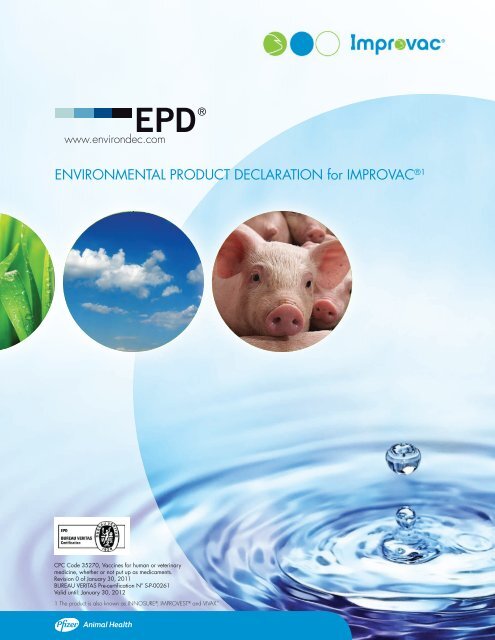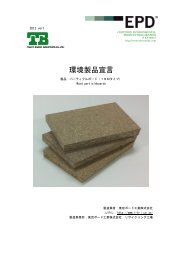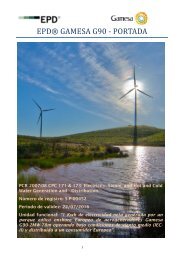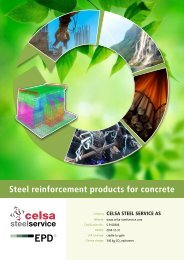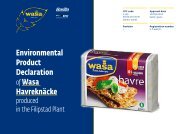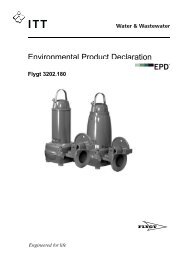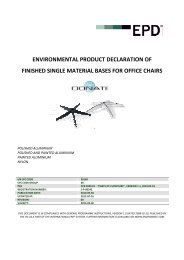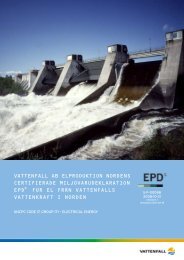ENVIRONMENTAL PRODUCT DECLARATION for IMPROVAC®1
ENVIRONMENTAL PRODUCT DECLARATION for IMPROVAC®1
ENVIRONMENTAL PRODUCT DECLARATION for IMPROVAC®1
Create successful ePaper yourself
Turn your PDF publications into a flip-book with our unique Google optimized e-Paper software.
COMPANY AND <strong>PRODUCT</strong> RELATED INFORMATION———————————————————————————————————————————————————————The CompanySince Pfi zer was founded by cousins Charles Pfi zer and Charles Erhart in 1849, it has remaineddedicated to discovering and developing new and better ways to prevent and treat disease andimprove health and well being <strong>for</strong> people around the world. As the leading biopharmaceutical companyin the world, Pfi zer applies science and its global resources to set the standard <strong>for</strong> quality, safety andvalue in the discovery, development and manufacturing of medicines <strong>for</strong> people and animals.With its acquisition of Wyeth’s Fort Dodge Animal Health business, Pfi zer Animal Health, a Pfi zerbusiness unit, also is now the world’s leader in the discovery, development and manufacture ofveterinary-prescription medicines. And, with a robust pipeline of biological and pharmaceuticalproducts, Pfi zer Animal Health is expanding its leadership role in meeting unmet, veterinary care needs.Pfi zer Animal Health supports veterinarians and food animal producers who work to ensure a safe,sustainable global food supply from healthy food-producing species (poultry, swine, cattle and fi sh).A full complement of prescription and over-the-counter therapies <strong>for</strong> the family pet or horse also helpscaregivers ensure that their companion animals live longer, healthier lives. Pfi zer Animal Health’s ownsales and veterinary care experts now support veterinarians and their customers in more than 60countries across the globe.Pfizer Animal Health – A Timeline1971Central Research Divisionestablished, combiningpharmaceutical, agriculturaland chemical R&D worldwide1995Pfi zer Animal Health Divisionacquired SmithKline BeechamAnimal Health (NordenLaboratories)1999Pfi zercelebratedits 150thanniversary2007Acquisition of Embrex,an internationalagricultural biotechnologycompany dedicated tothe poultry industry1800 1850 1900 1950 20001849Charles Pfi zer & Companyfounded in Brooklyn, New York1912Fort DodgeAnimal Healthopens asmall serummanufacturing1952Pfi zer established Agricultural Divisionand opened 700-acre farm andresearch facility in Terre Haute, Indiana1988Agricultural DivisionrenamedAnimal HealthDivisionplant in Iowa 2003Acquisition of Pharmacia and establishment ofPfi zer Animal Health’s worldwide R&Dheadquarters in Kalamazoo, Michigan2009Pfi zer Animal Healthacquired Fort DodgeAnimal HealthAcquisition of CSL Animal Health,including CSL’s U.S. subsidiaryBiocor, located in Omaha, Nebraska2
The ProductImprovac is an immunological product that canbe used in pig management as an alternative tophysical castration <strong>for</strong> the control of boar taint,an offensive off odor and taste caused bycompounds such as androstenone and skatole 2that can accumulate in the fat of entire malepigs 3 following the onset of puberty. Improvac’smode of action is similar to a vaccine, and in many countries it isclassifi ed as a vaccine. In others, it is classifi ed as an immunologicalproduct, depending on the country’s regulatory criteria.The safety and effectiveness of Improvac, including safety <strong>for</strong> human health,have been assessed by regulatory authorities, including the European MedicinesAgency. The product has been approved <strong>for</strong> use and granted a zero-day withdrawal,which means that no interval is required from a safety perspective between the timethe animal receives Improvac and when it may be slaughtered and enter the humanfood supply 4 .2 Androstenone is a “male reproductive pheromone” chemically related to testosterone. It is produced by the testes of pigs after puberty and accumulates in fat. Skatole is produced in thegut of all pigs but skatole absorbed into the body is normally eliminated by the liver. This process is slower in pigs under the infl uence of male hormones, meaning that entire male pigshave a tendency to accumulate skatole.3 An “entire male” (not castrated) pig is also called “boar”.4 More details about IMPROVAC are available on web site of European Medicine Agency (EMEA): http://www.ema.europa.eu/ema/index.jsp?curl=pages/medicines/veterinary/medicines/000136/vet_med_000130.jsp&murl=menus/medicines/medicines.jsp&mid=WC0b01ac058001fa1c3
Although not a food safety issue, effective control of boar taint is essential <strong>for</strong> the pork marketbecause of its potential negative effect on perceptions of meat quality. While sensitivity varies,a high proportion of consumers, particularly women and certain ethnic group individuals, detectthe off odors, which have been described as similar to urine, musk, perspiration, onions or feces.Physical castration is currently the most common method of controlling boar taint; worldwide more than95% of male pigs are estimated to be physically castrated. Although successful in reducing boar taint,physical castration has a negative effect on the growth per<strong>for</strong>mance of pigs.Specifi cally, when compared to entire male pigs (boars), castrated pigs (barrows) are less effi cient atconverting feed 5 into body weight and tend to have lower quality carcasses with more fat and lesslean meat. In addition, physical castration is associated with increased mortality among male pigletsand is now perceived as an animal welfare issue by many consumers and advocacy groups.Improvac is as effective as physical castration in controlling off odors in pork. Improvac is administeredonly a few weeks prior to the time of slaughter. This protocol allows male pigs to grow naturally andmore effi ciently as boars <strong>for</strong> most of their lives, in contrast to physical castration which, <strong>for</strong> practicalreasons, must be per<strong>for</strong>med early in life. In addition, by allowing males to grow and spend the betterpart of their lives without intervention, pigs on the Improvac program naturally eat less4
feed, create less waste, and have carcasses with a greater percentage of lean meat thanbarrows. This improved effi ciency, in turn, should provide both direct and indirectenvironmental benefi ts, principally due to reductions in feed consumption and slurry(manure) generation.The scope of this Declaration is to quantify the environmental impact of Improvac use.For this reason, the whole pork meat production chain is taken into account from alife cycle assessment (LCA) perspective, covering Improvac manufacturing and pigproduction from gestation, birth, and growing through harvest. 6Although the LCA also compared the environmental burden of the Improvac system with themore traditional physical castration system, that data is not presented here, as it is out of scopein the EPD <strong>for</strong>mat. This comparison will be included as part of a subsequent publication.The plants and their suppliersImprovac production is based on the use of a set of specifi c substances, coming from a selectedgroup of suppliers. Specifi c data were requested from these suppliers <strong>for</strong> inclusion in the LCA. Themanufacturing plants that produce Improvac are located in the United States (Kalamazoo, Michigan),Belgium (Louvain la Neuve, Ottignies) and Australia (Parkville, Melbourne). Taking into account annualproduction on a global level, 80% of Improvac comes from Belgium, 15% from Australia, and 5% fromthe United States, to be delivered world-wide. The environmental burden of transporting the productfrom the three production facilities to the farms where it will be used has been taken into account in theanalysis calculations.5 Data about comparison between male pig and castrated pig in terms of feed conversion effi ciency are available in Pfi zer reference documents:• Meta-analyses of Pfi zer IMPROVAC ® dossier studies (preliminary analyses June 16th 2010) - Dunshea.• Impact of using vaccination with IMPROVAC ® rather than physical castration on the carcass characteristics of fi nishing male pigs. University of Illinois at Urbana-Champaignand Pfi zer Animal Health March, 2009.6 “Harvest” refers to slaughter of the pig subsequent isolation of the meat and products that are ready <strong>for</strong> movement either to retail or <strong>for</strong> further processing.5
<strong>ENVIRONMENTAL</strong> PERFORMANCE – RELATED INFORMATION———————————————————————————————————————————————————————This chapter provides relevant technical in<strong>for</strong>mation about the Improvac system, including the adoptedboundaries and the results of the life cycle assessment study. As noted previously, data comparingthe Improvac system with the physical castration system is not presented, as it is out of scope withthe EPD <strong>for</strong>mat.MethodologyThe environmental burden of the product has been calculated according to the general rules of theEPD (Environmental Product Declaration) International Programme 7 ; currently, the specifi c PCR (ProductCategory Rules) document is not available <strong>for</strong> this product group.This declaration is based on the application of Life Cycle Assessment (LCA) methodology8 to theImprovac life-cycle system. The LCA report constitutes the most important background document andrepresents the principal source of in<strong>for</strong>mation and data to be used <strong>for</strong> environmental communicationabout Improvac and the environmental life-cycle burden associated with its use in swine production.To assess the burden of Improvac production at the facility level, detailed data and in<strong>for</strong>mationwere collected both from Improvac manufacturing facilities (Kalamazoo, USA, Louvain la Neuve,Belgium, and Melbourne, Australia) and from production facilities of raw material suppliers (inparticular, Lincoln, Nebraska).At the use phase, , regional data was collected from commercial farms that use a physical castration(baseline) management system, with a maximum pig slaughter age of 30 weeks. The in<strong>for</strong>mation was7 The International EPD ® System is managed by the International EPD Consortium - IEC (www.environdec.com)8 The LCA methodology is standardized at international level by ISO 14040 and ISO 14044.9 At the beginning of the project a detailed list was created to identify coordinators <strong>for</strong> data collection at farm level by macro-Regions on a global scale. Each coordinatorwas assisted by “supporters” who are based in a specifi c country/region belonging to the macro-region with the goal of collecting data as later explained.6
obtained by regional coordinators 9 who know the sector and have an appreciation of the existingrealities at the local level. Each coordinator managed a macro-region, contributing to data collectionon a global scale.Customized LCA questionnaires were used to gather in-depth in<strong>for</strong>mation about all aspects of the farmsystem (<strong>for</strong> example, energy use, feed and water consumption, animal care, air emissions and manuremanagement, fi nishing and harvest data), ultimately providing a complete picture of the environmentalburden of the baseline system. To assess the burden of the Improvac system, data from study trialreports conducted around the world (verifi ed reports of Improvac studies involving third parties whichcontain details of diet composition, feed intake, weight of animals to be slaughtered and other relevantdata) were applied to the baseline data in order to allow a calculation of the environmental burdenof the Improvac system with respect to a baseline scenario in which young, male pigs are physicallycastrated.Data was obtained from farms and slaughterhouses in China, Japan, The Netherlands, France, Italy,UK, Canada, Mexico, Chile and Brazil. In addition to these data, selected literature sources fromAustralia and USA as indicated in the references chapter were utilized in the LCA model.Functional UnitImprovac is an immunological product that effectively and safely reduces boartaint 10 by using the pig’simmune system to prevent the accumulation of androstenone and skatole in male pigs. The mode ofaction is sometimes referred to as immunological castration and, as noted previously, it is an alternativeto physical castration. Two doses (2 ml/dose) represent the exact quantity of Improvac that is thenecessary to obtain the full effect in one animal.With regard to the Improvac use phase, a functional unit was defi ned on multiple levels relating theuse of two doses of the vaccine to a particular output. The primary output is the live pig (kg live-weight),but values also have been calculated <strong>for</strong> the pig carcass (kg of carcass after dressing) and boneless/fatless pork meat at the gate of the slaughterhouse (kg of lean meat), as these are more relevantmeasurements <strong>for</strong> some companies in the pork production chain. 11Extending the functional unit defi nition to include three different outputs provides a complete overviewof the system, from Improvac production to pork meat that is ready <strong>for</strong> transport to retail outlets.Packaging and transportation to retail outlets and to the consumer are not included in the analysis.The decision to include LCA results on mass of live-weight pig and mass of pork meat refl ects theopportunity to more completely describe the Improvac system with respect to the baseline scenario thatis represented by the physical castrated pig system.10 As noted previously, boar taint is an offensive odor and taste evident in meat from some intact male pigs due to the accumulation in fat tissue of primarily two substances—androstenone(a testicular steroid) and skatole (a product of microbial tryptophan breakdown in the gut).11 Dressing refers to the process of preparing a pig carcass, including removal of offal. Lean meat is defi ned as “fat free lean”, which essentially means muscle tissue; the value is oftenexpressed as a percentage of carcass weight. It is an important parameter in the industry and is often used as part of the basis <strong>for</strong> payment to pig producers.7
System boundaries and main hypothesesThe system boundaries considered in this analysis (see Figure 1) include:• Raw materials used in the Improvac pool (includes all production processes steps from extractionfrom the earth through production of the primary Improvac constituents) ;• Production processes associated with product <strong>for</strong>mulation and packaging at the three productionfacilities (Kalamazoo, Louvain La Neuve and Parkville);• Improvac transportation from production facilities to farms;• Use phase at the farm level <strong>for</strong> one pig;• Pig transport to slaughterhouse; and• Slaughterhouse activities <strong>for</strong> the production of one kg of pork meat.In the whole LCA model, infrastructures and production equipment are not taken into account.Figure 1. Scheme of the considered system boundaries (including upstream, core and downstream main processes).SYSTEM BOUNDARIESImprovac poolPackagingUPSTREAM PROCESSESDEAE Dextran productionConjugate prod’nPreservative prod’nCap and bottle prod’nPackagingAuxiliary materialsCORE PROCESSFacilityKalamazoo (US),Louvain la Neuve(Belgium) andMelbourne (Australia)plantsImprovacproductionprocessDOWNSTREAMPROCESSESMeat prod’nPig breedingand rearingImprovac usephase (2 doses)Improvac transportto the farmsFarm Slaughterhouse8
According to Figure 1, the Improvac system can be there<strong>for</strong>e divided into three main parts:• UPSTREAM PROCESSES, where raw materials and Improvac constituents are generated;• CORE PROCESS, where Improvac is produced; and• DOWNSTREAM PROCESSES, including the use phase at the farm and the slaughterhouse<strong>for</strong> pig meat production.1) UPSTREAM PROCESSES (RAW MATERIALS <strong>PRODUCT</strong>ION)The two most signifi cant considerations in the upstream processes are the raw materials and energythat go into production of the three primary constituents of Improvac:• DEAE Dextran;• Conjugate;• Preservative.For each of these, a detailed process analysis has been per<strong>for</strong>med using direct data from suppliers’plants. (See Figure 2.)Figure 2. Scheme of upstream processes.UPSTREAM PROCESSESRaw materialsPeptideprod’nDiphteria Toxoid(DT) prod’nEnergyEnergyConjugateprod’nDEAE dextranPreservativeprod’nRaw materials9
2) CORE PROCESS (IMPROVAC <strong>PRODUCT</strong>ION)The Core Process analysis takes into account resources, emissions and wastes that go into or are givenoff during the production of Improvac (see Figure 3). Improvac constituents (described in the UpstreamProcesses) and packaging materials, as well as electricity and fuels, are transported to a productionfacility, where the fi nal product is <strong>for</strong>mulated. Wastes and air and water emissions are given off as aresult of the <strong>for</strong>mulation process.The analysis covers Improvac production processes <strong>for</strong> the “two dose” functional unit at the threedifferent production facilities (Kalamazoo, Louvain La Neuve and Parkville), and the assessment resultsrefer to the average two dose unit, calculated using a weighted mean that takes into account differentproductions levels at each plant.Figure 3. Scheme of core processSTARTING MATERIALS<strong>PRODUCT</strong>IONImprovac poolCORE PROCESStransportCONJUGATEOthersubstancesWASTEPACKAGINGMATERIALS <strong>PRODUCT</strong>ION<strong>PRODUCT</strong>ION(currently in vialsof 50 doses)AIR EMISSIONSENERGY <strong>PRODUCT</strong>ION• electricity• fuelstransportWATEREMISSIONS10
3) DOWNSTREAM PROCESS (USE PHASE AND END OF LIFE)The Downstream Process refers to the following activities (see Figure 4):• Activities related to pig management at the farm level with a life-cycle perspective;• Improvac application 12 ; and• Harvest.Results are calculated by an average among the world-wide macro-regions that participatedin the project.Figure 4. Scheme of downstream processDOWNSTREAM PROCESSInput fromtechnosphereFARMPig transportEnergySLAUGHTERHOUSEInput fromenvironmentWasteAir emissionsWater emissions12 Where applicable, transportation of individuals who administer Improvac to pigs on the farm was taken into account.11
Environmental per<strong>for</strong>manceThe detailed environmental per<strong>for</strong>mance (in terms of use of resources, pollutant emissions andwaste generation) of the Improvac system is presented <strong>for</strong> the three processes, Upstream, Core andDownstream, by means of the “two doses” and “one kg of pig live weight” functional units.For a restricted set of indicators, such as the Carbon Footprint 13 and the Total Energy Consumption,the environmental burden is also reported in terms of “one kg of carcass after dressing” and “one kgof lean meat” in the Additional In<strong>for</strong>mation chapter of this Declaration.Use of resources [consumption of renewable, non-renewable and water resources]Results about the use of resources are split into three sections:1. Renewable resources (Table 1);2. Non-renewable resources (Table 2); and3. Water use (Table 3).13 In this context, the carbon footprint is the overall amount of carbon dioxide (CO 2) and other greenhouse gas (GHG) emissions(such as methane) associated with the Improvac system along its supply-chain, the use phase and the end-of-life. In other words,a carbon footprint is a life cycle assessment with the analysis limited to emissions that have an effect on climate change.12
Table 1. Total renewable resources used in the Improvac system (rounded data).RENEWABLE RESOURCESFUNCTIONAL UNITTotal of material resources –data in g (grams)Energy resources –data in MJTotal of energy resources –data in MJUPSTREAMPROCESSES2 doses ofIMPROVACCOREPROCESSES2 doses ofIMPROVACDOWNSTREAMPROCESSES1 kg of piglive weight
Pollutant emissions to water and airEmissions to the environment are reported by means of a set of specifi c indicators belonging tointernationally recognized impact categories. Results are available in Table 4.Table 4. Total potential environmental impacts of the Improvac system (rounded date)IMPACT INDICATORSFUNCTIONAL UNITUPSTREAMPROCESSES2 doses ofIMPROVACCOREPROCESSES2 doses ofIMPROVACDOWNSTREAMPROCESSES1 kg of piglive weightGlobal Warming Potential (GWP)from fossil fuelsg CO 2equiv. 5 28 6273Global Warming Potential (GWP)from bio 14 g CO 2equiv. 15 6 1 349Acidification g SO 2equiv. 0,03 0,07 51,20Eutrophication3-g PO 4equiv. 0,02
With regard to Improvac production (upstream and core processes), the main contributors to theenvironmental impact categories are identifi ed: about Global Warming Potential from fossil resourcesuse, the electricity-related processes are responsible <strong>for</strong> approximately 57% of the impact; thedominant contribution to the Global Warming Potential from biogenic sources comes from the DEAEDextran production, deriving from a microbial fermentation of ethanol.About the Acidifi cation impact category, the hard coal burning, at power plant, <strong>for</strong> electricityproduction is the dominant player; fi nally, <strong>for</strong> the Eutrophication impact category the most relevantcontributor depends on the biomass <strong>for</strong> ethanol production (DEAE Dextran production).Solid Waste generationData concerning solid waste generation are split into two categories – hazardous and not hazardous– and refer to the whole system (Table 5).Table 5. Total waste generation <strong>for</strong> the Improvac system (data in grams).WASTE <strong>PRODUCT</strong>ION(g)FUNCTIONAL UNITUPSTREAMPROCESSES2 doses ofIMPROVACCOREPROCESSES2 doses ofIMPROVACDOWNSTREAMPROCESSES1 kg of piglive weightHazardous 0,02
ADDITIONAL INFORMATION———————————————————————————————————————————————————————This chapter is intended to provide specifi c additional in<strong>for</strong>mation about the Improvac system as wellas some comments of its environmental added value with respect to the baseline scenario that isrepresented by castrated animals.Taking into account the relevance of the Carbon Footprint and Total Energy Consumption indicators,Table 6 summarizes the results <strong>for</strong> the three functional units, including one kg of (lean) pork meat.Table 6. Carbon Footprint & Total Energy Consumption <strong>for</strong> the three functional units considered in the LCA<strong>for</strong> Improvac (rounded data)IMPACT INDICATORS1 kg of piglive weight1 kg of pigcarcass afterdressing1 kg of leanmeatGlobal Warming Potential(GWP) [carbon footprint]kg CO 2equiv. 6,70 8,75 15,82Total Energy Consumption 16 MJ 22,5 29,4 53,1Figure 5 shows the most relevant contributors to the Carbon Footprint Indicator.Figure 5. The Most relevant contributors to the Carbon Footprint Indicator of the Improvac system 17 .Contributors to the Carbon FootprintImprovac production =0,04 kg CO 2eq. <strong>for</strong> 2 doses (0,01%)Pig RationHousing SystemSlurry Management14%3%7% 0%23%SlaughterhouseSow ManagementDOWNSTREAMPROCESSTransport3%9%Animal WasteIncinerationImprovacProductionUPSTREAM ANDCORE PROCESSES41%16 The feedstock energy amount of feed is not included.17 The sow management phase includes the environmental impact related to the sow’s feed intake used <strong>for</strong> the production of piglets, subsequently treated with Improvac.(Reference data used <strong>for</strong> the analysis is 20 piglets per sow per year)16
Although comparative data are not included in this EPD 18 , the LCA study shows a clear environmentalbenefi t <strong>for</strong> important impact indicators, in particular GWP, <strong>for</strong> the Improvac system vs. a baselinescenario (i.e., physical castration). When such a comparison is made, the data demonstrate that,because the use of Improvac to reduce off odor in meat of male pigs allows farmers to discontinuephysical castration, the Improvac system has the added value of a reduced environmental life-cycleburden with respect to the traditional scenario.PFIZER AND THE ENVIRONMENT———————————————————————————————————————————————————————Pfi zer has a long-standing commitment to environmental, health and safety protection. The Companyis building on the strengths of its environmental programs to enhance sustainable practices throughoutits businesses.Effective management of the natural and workplace environment is one of Pfi zer’s highest corporatepriorities. It is the Company’s policy to:• Seek continuous improvement in environmental per<strong>for</strong>mance,• Maintain safe and environmentally sound manufacturing operations,• Integrate environmental considerations into research and product development activities, and• Contribute to the common ef<strong>for</strong>t to protect the environment in nature and in the workplace.While Pfi zer is proud of initiatives to ensure full compliance with legal requirements and its manyachievements over the years, the Environmental Sustainability Program is designed to develop a moreintegrated and strategic approach. The following are among actions underway:• Setting near-term and longer-range priorities <strong>for</strong> environmental activities with guidance from businesspartners and stakeholders,• Communicating and engaging with stakeholders on issues and progress, and• Maintaining a foundation that aligns with Pfi zer’s overall Corporate Responsibility pledge to reduceenvironmental impact globally.Comprehensive assessments have led Pfi zer to recognize environmental ef<strong>for</strong>ts that are important tostakeholders and that also can drive business success. Internal interviews, external benchmarking, bestpractice reviews and value proposition evaluation pointed to three key strategic priorities. Three areasof focus — climate change mitigation, product stewardship, and access to clean water — emergedand <strong>for</strong>m the basis of Pfi zer’s environmental sustainability roadmap. Short-term and long-term activitiestarget these priorities.For more in<strong>for</strong>mation about Pfi zer and the environment, visit:www.pfizer.com/responsibility/protecting_environment/environmental_sustainability.jsp18 Inclusion of comparisons between systems is not within the boundaries of an EPD.17
GLOSSARY———————————————————————————————————————————————————————Acidification Potential (AP)Phenomenon by which atmospheric rainfall has a lower pH. This may cause damage to <strong>for</strong>ests and crops, as wellas to water ecosystems and objects in general. This phenomenon is due to the emissions of SO 2, NOx, and NH 3,which are included in the Acidification Potential (AP) index expressed in masses of H+ produced.Ozone Depletion Potential (ODP)Degradation and depletion of the ozone layer of the stratosphere, which has the property of blocking the ultravioletcomponents of sunlight thanks to its particularly reactive compounds, originated by chlorofluorocarbons (CFC) or bychlorofluoromethane (CFM).The substance used as an indicator <strong>for</strong> assessing the ODP (Ozone Depletion Potential) is trichlorofluoromethaneor CFC-11.Global Warming Potential (GWP)Phenomenon by which the infrared rays emitted by the Earth’s surface are absorbed by the molecules in theatmosphere as a result of solar warming: and then re-emitted in the <strong>for</strong>m of heat, increasing the process rate ofatmospheric global warming. The indicator used <strong>for</strong> this purpose is GWP (Global Warming Potential). This mainlyincludes the emissions of carbon dioxide, the main greenhouse gas, as well as other gases that lead to infrared rayabsorption, such as methane (CH 4), nitrogen protoxide (N 2O), chlorofluorocarbons (CFC), which are expressedaccording to the degree of absorption of CO 2. The potential is calculated on a mass basis <strong>for</strong> the time horizon 100years – (g CO 2-equivalents).Eutrophication Potential (EP)Enrichment of the watercourses by the addition of nutrients. This causes imbalance in water ecosystems due tooverdevelopment stimulated by the excessive presence of nourishing substances. In particular, the EutrophicationPotential (EP) includes phosphorous and nitrogen salts and is expressed in grams of oxygen (g O 2).Photochemical Ozone Creation Potential (POCP)Production of compounds that are capable of stimulating an oxidizing reaction due to the action of light, leadingto the production of ozone in the troposphere. The indicator POCP (Photochemical Ozone Creation Potential)especially includes VOC (volatile organic compounds) and is expressed in grams of ethylene (g C 2H 4).Total Energy ConsumptionIs the overall amount of energy involved in a production system. This is the energy used when all materials and fuelsare traced back to the extraction of raw materials from the earth and is a measure of the total energy resource thatmust be extracted from the earth in order to support the system.18
REFERENCES————————————————————————————This declaration and further in<strong>for</strong>mation about it areavailable at www.environdec.com.Specific requirementsThe calculation of the environmental impact of theproduct (Improvac, in this case) was conductedaccording to the general EPD ® requirementsContactsTo get more in<strong>for</strong>mation about this environmentaldeclaration or about Pfizer’s corporate activitiesplease contact:Mr. Paulo MoraesSenior Marketing Managerpaulo.moraes@pfizer.comTechnical support to Pfizer was providedby Life Cycle Engineering, Italy.(info@studiolce.it, www.studiolce.it).ESSENTIAL BIBLIOGRAPHY————————————————————————————EU Commission (2003) - Integrated Pollution Preventionand Control (IPPC) Reference Document on Best AvailableTechniques <strong>for</strong> Intensive Rearing of Poultry and Pigs -EU Commission – IPPC; 2003.EU Commission (2005) - Integrated Pollution Preventionand Control Reference Document on Best AvailableTechniques in the Slaughterhouses and Animal By-productsIndustries - EU Commission – IPPC; 2005.IPCC National Greenhouse Gas Inventories Programme(1996) - Conceptual Basis <strong>for</strong> Uncertainty Analysis - GoodPractice Guidance and Uncertainty Management inNational Greenhouse Gas Inventories, Annex 1; 1996.ISO (2006) - Environmental management - Life cycleassessment - Principles and framework - EN ISO 14040;2006ISO (2006) - Environmental management - Life cycleassessment - Requirements and guidelines - EN ISO14044; 2006.Life Cycle Engineering (2010) - Life Cycle Assessment(LCA) of Improvac (a vaccine <strong>for</strong> veterinary uses) <strong>for</strong>EPD/CD purposes;Rural Industries Research and Development Corporation,Australian Government and Australian Pork Limited (2010)- Environmental Assessment of Two Pork Supply ChainsUsing Life Cycle Assessment – January 2010.Swedish Environmental Management Council (2008)- General Programme Instructions (EPD ® ) - ver. 129/02/2008;University of Arkansas, Applied Sustainability Center(2010) - National Scan-level Carbon Footprint Study<strong>for</strong> Production of US Swine - University Press, 2010.PAS 2050:2008 “Specification <strong>for</strong> the assessment ofthe life cycle greenhouse gas emissions of goods andservices” BSI (British Standard Institution), 2008.GHG Protocol Initiative “Product Life Cycle Accountingand Reporting Standard” World Resources Institute &World Business Council <strong>for</strong> Sustainable Development,2010EU Commission (2006) - IPCC Guidelines <strong>for</strong> NationalGreenhouse Gas Inventories Volume 4: Agriculture,Forestry and Other Land Use - EU Commission – IPPC;2006.19
www.environdec.comIndependent verificationIndependent verifi cation of the declaration and data,according to ISO 14025:■ Internal■X ExternalThird party verifi er:Bureau Veritas Group (http://www.bureauveritas.com).PCR: PCR document is still not available.Valid until: January 30, 2012IMPROVAC, IMPROVESTand INNOSURE and areregistered trademarks of Pfi zer Inc.© 2011 Pfi zer Inc. All rights reserved.


